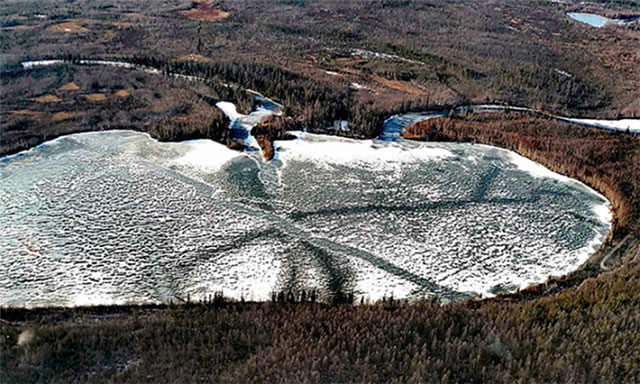Russian researchers plan to dive approximately 30 meters deep to explore Lake Cheko, believed to be the impact site of a meteorite.
Russian scientists will travel to the remote Tunguska Nature Reserve in Krasnoyarsk, Central Siberia, at the end of February, according to Siberian Times. The research team, consisting of four members, has been authorized to dive deeper than 30 meters. This is the first study to be conducted at such depths in Lake Cheko, Tunguska. The expedition will initiate a long-term research cycle, as stated by Evgenia Karnoukhova, an expert at the Tunguska Reserve.

Lake Cheko in Siberia, Russia. (Photo: Evgenia Karnoukhova)
“Lake Cheko is 54 meters deep. The research team aims to understand the thickness of sediments at the bottom of the lake and collect primordial samples. The data they gather will be analyzed and sent to geologists. We are not yet discussing the search for any celestial bodies at this stage,” said Evgenia.
The Tunguska event of 1908 continues to spark debate within the scientific community. The incident flattened an area of 2,150 km2 and destroyed approximately 80 million trees. Some witnesses reported seeing a bright fireball moving across the sky.
In 1927, Russian mineralogist Leonid Kulik led the first Russian expedition to investigate the Tunguska event. However, this expedition also failed to find any meteorite impact crater or extraterrestrial material.
In 2012, a research team from the University of Bologna, Italy, led by expert Luca Gasperini, proposed that Lake Cheko, which has a diameter of 500 meters and a bowl-like shape, is the impact crater. This body of water is located about 8 km from the hypothesized epicenter. Previously, it had not been marked on maps. Seismic measurements at the lake’s bottom indicated that sediments have accumulated over about a century, and the lake’s depth is also greater than the usual levels in this region.
The research team concluded that there is dense rock material beneath the lakebed, and the sediment layer is a remnant of the exploded meteorite. They reported that seismic reflection and magnetic data indicate an anomaly near the center of the lake, at a depth of less than 10 meters below the lakebed. This anomaly is consistent with the presence of a buried rock object and supports the hypothesis that Cheko is a lake formed from an impact crater.
However, in 2017, a group of scientists from Krasnoyarsk and Novosibirsk, Russia, opposed this hypothesis. They argued that the area had not been fully mapped, so the absence of Lake Cheko from older maps was not surprising.
The team of experts assessed the dating by studying the lakebed sediments, conducting geochemical and biochemical analyses. Their colleagues from the Geological and Mineralogical Institute of the Siberian Branch of the Russian Academy of Sciences (RAS) completed the radioactive analysis of the core samples.
The deepest sample they obtained was dated to be around 280 years old. Thus, Lake Cheko appears to be geologically young, but not young enough to be the impact crater from the Tunguska event. Additionally, the Tunguska Reserve contains other relatively round and deep lakes resembling Lake Cheko, which may share a similar geological origin.


















































